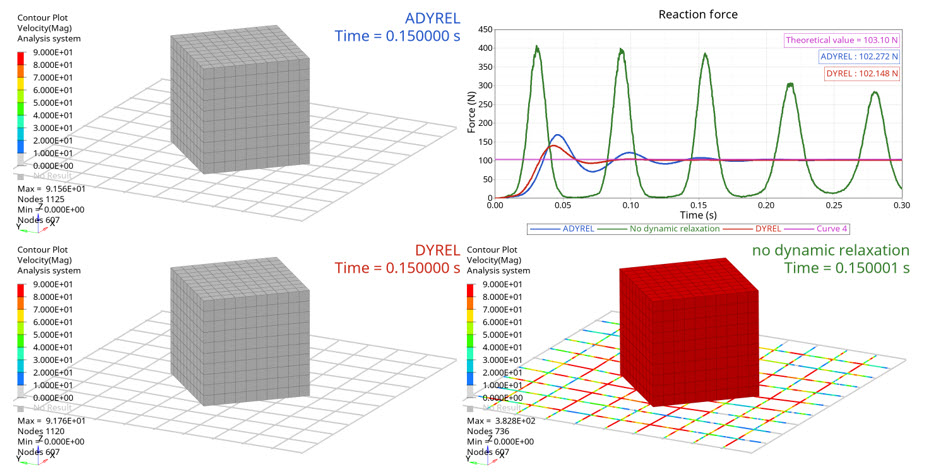RD-V: 0120 Edge-to-Edge Contact
Edge-to-edge contact between beam and shell element under gravity loading with dynamic relaxation.

Figure 1. Results
The subject of this study is to analyze the quality of Radioss quasi-linear simulation using a simple use case.
- Without any dynamic relaxation
- With user-defined dynamic relaxation period
- With automatic dynamic relaxation (Radioss dynamically selects the relaxation period)
The reaction force result is extracted from the anchorage and compared to the theoretical value.
Options and Keywords Used
Input Files
Refer to Access the Model Files to download the required model file(s).
Model Description
Units: Mg, s, mm, MPa
A cube (100mm*100mm*100mm) modeled with shell elements (/PROP/SHELL) and elastic steel material (/MAT/ELAST) is set on a steel wire net under gravity loading.
The cube is defined inside a submodel (//SUBMODEL) which is translated and rotated (/TRANSFORM) to be positioned on the top of the wire net. The total mass of the cube with an added mass is 10kg (/ADMAS).

Figure 2. Components positions. left: before transformation; right: after transformation
The nodes on the outer boundary of the wire net are clamped through a rigid body (/RBODY + /BCS). The rigid body is used to measure the reaction force (/TH/RBODY).
A vertical gravity (/GRAV) of 1G is defined on all nodes of the model.
The theoretical reaction force is F = 103.1 N.
Results
In all cases, the edge-to-edge contact interface shows good behavior and gravity load is correctly transmitted to the rigid body.
Only the models with dynamic relaxation converge to the right solution within a reasonable computation time.
The automatic dynamic relaxation (/ADYREL) converges more slowly than the manual dynamic relaxation (/DYREL), where you need to define the relaxation period.
But, with /ADYREL, there is no need to compute the model without dynamic relaxation to know the relaxation period to use.
The vertical reaction force of the rigid body gives a value very close to the theoretical value (less than 1% difference). Figure 1.